See what API testing solution came out on top in the GigaOm Radar Report. Get your free analyst report >>


See what API testing solution came out on top in the GigaOm Radar Report. Get your free analyst report >>
Advanced automated testing methodologies enable development and QA teams to identify and mitigate hazards and vulnerabilities to deliver compliant code that’s safe, secure, and reliable.
Software Compliance Testing > by Method
Our solutions ensure regulatory compliance by facilitating adherence to a comprehensive range of standards encompassing coding, functional safety, security, and other regulatory and compliance requirements. With thorough software compliance testing, we mitigate risks and ensure project success.

Jump to: Testing Methods for Embedded »
Jump to: Testing Methods for Enterprise »



Testing embedded software for safety and security is crucial for reliability and compliance in critical environments like automotive and aerospace. Rigorous testing detects faults early, ensures regulatory compliance, and prevents failures that could be life-threatening.
Static analysis is a cornerstone in building embedded safety and security-critical applications in C and C++. Our test automation solutions for C/C++ software development offer a proactive approach to error detection, identifying potential issues such as buffer overflows, memory leaks, and security vulnerabilities before they manifest during program execution. This early detection significantly reduces the cost and effort required for bug fixing and enhances the reliability of the codebase.
Static analysis ensures compliance with industry-specific safety standards like ISO 26262 and DO-178C, which are crucial in sectors such as automotive and aerospace. Static analysis using standards like MISRA contributes to code quality improvement by identifying coding issues and areas for enhancement, such as reducing cyclomatic complexity and eliminating code duplication.
By integrating static analysis into the development pipeline, developers can continuously assess code changes, prevent regressions, and strengthen the overall security posture of embedded systems. Ultimately, static analysis is indispensable for mitigating risks, enhancing safety and security, and ensuring robustness in embedded applications in critical environments.
Read Blog: Best Practices for Using Static Analysis Tools »

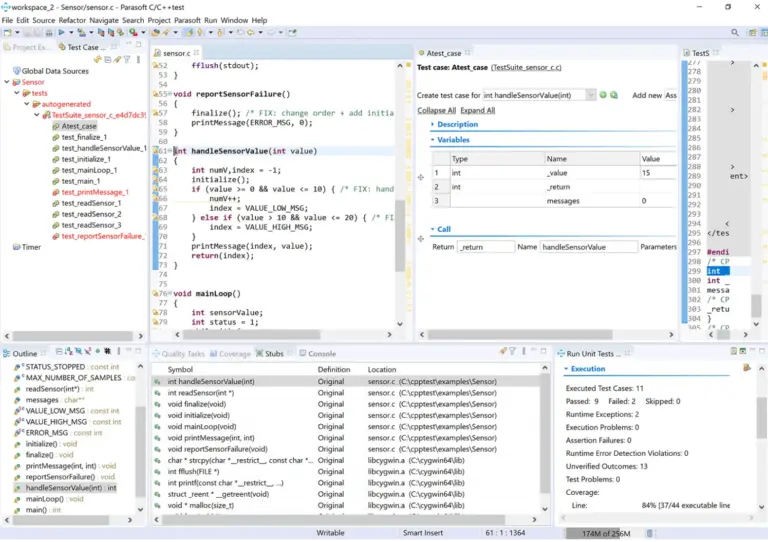
Unit testing is indispensable for developing embedded safety and security-critical applications in C and C++, providing a systematic approach to validating individual units of code. Development teams can automate writing and executing unit test cases with Parasoft’s C/C++test comprehensive unit testing framework for C/C++ software development to verify implementation accuracy and detect defects early in the development process.
Parasoft’s proactive approach to testing helps to uncover bugs, logic errors, vulnerabilities, and edge cases before they propagate to higher levels of integration, reducing the likelihood of critical failures in production. Unit testing plays a crucial role in ensuring compliance with safety and security standards and regulations. It demonstrates the functionality, reliability, and integrity of individual components in isolation.
Our unit testing solutions for C/C++ integrate into the continuous integration (CI) pipeline to automate the execution of tests and quickly identify regressions or breaking changes introduced by new code modifications. This iterative testing approach fosters confidence in the codebase, accelerates development cycles, and ultimately contributes to safe, secure, and reliable embedded systems.
Read Blog: The Value of Using a Unified C/C++ Testing Tool »
Structural code coverage analysis is fundamental for building embedded safety and security critical applications in C and C++. It provides insight into the extent to which the source code has been exercised by test cases. By measuring coverage metrics like statement, branch, and modified condition decision coverage (MC/DC), developers can assess the thoroughness of their testing efforts and identify areas of the codebase that require additional scrutiny.
Structural code coverage demonstrates that the code has been adequately tested and that all critical paths have been exercised. This is particularly important in safety-critical industries such as automotive and aerospace, where adherence to standards like ISO 26262 and DO-178C is mandatory. Parasoft’s code coverage solutions for C/C++ ease the efforts of achieving 100% structural code coverage for compliance with such safety standards and regulations.
Integrating structural code coverage analysis into the continuous integration (CI) pipeline enables developers to monitor coverage trends over time and identify regression issues introduced by code changes. This iterative testing approach promotes accountability and transparency within development teams, fostering a culture of quality and reliability.
Read Blog: How to Obtain 100% Structural Code Coverage of Safety-Critical Systems »
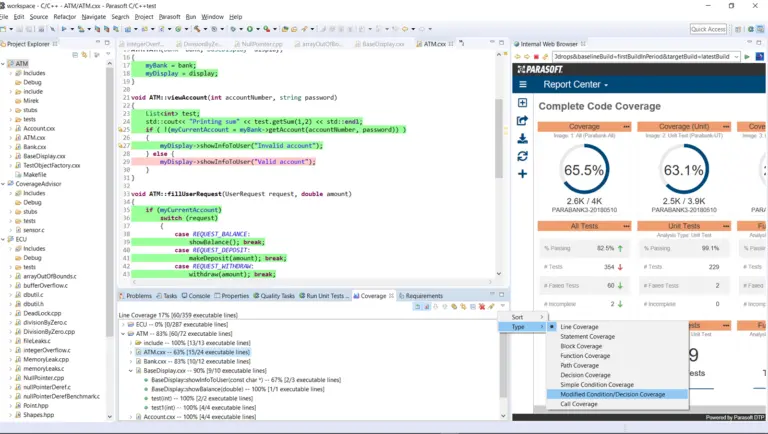

Functional safety and security compliance are paramount for developing embedded applications that operate in safety-critical environments. Functional safety ensures that systems operate correctly, reliably, and safely, while security compliance ensures protection against unauthorized access, data breaches, and malicious attacks.
Functional safety is governed by standards like ISO 26262 for automotive applications and IEC 61508 for industrial automation. Achieving functional safety compliance involves the systematic identification of safety goals, hazard analysis, and risk assessment. Similarly, security is guided by standards like ISO/SAE 21434 for automotive cybersecurity and other relevant standards for different sectors. These standards involve identifying security objectives, conducting threat assessments, and implementing appropriate security controls.
Parasoft’s solution for functional safety and security enables embedded development teams to satisfy the testing and software quality requirements that stem from safety and security compliance standards. This includes comprehensive testing, analysis, and documentation.
Read Blog: Deliver Regulatory Compliant Software Even Faster »
Requirements traceability is crucial for developing compliant embedded safety and security-critical applications in C and C++. It requires bidirectional links between system requirements, design specifications, test cases, and implementation details throughout the SDLC, which Parasoft’s automated testing solutions provide. By maintaining traceability between these artifacts, developers confirm that each requirement is adequately addressed and validated, ensuring the final product’s reliability and safety.
Our solutions automate traceability between requirements, tests, and code. This is essential for compliance with safety standards and regulations, as it demonstrates that the implemented code satisfies the specified requirements. In industries such as automotive and aerospace, adherence to standards like ISO 26262 and DO-178C requires comprehensive traceability to provide assurance that safety- and security-critical functions have been correctly implemented and verified.
Requirements traceability facilitates impact analysis and change management, enabling developers to assess the potential effects of modifications to requirements or design decisions on the implemented code. Our solutions map requirements to corresponding test cases and code artifacts, making it easier for developers to verify each requirement is adequately tested and changes are properly validated.
Read Blog: Requirements Management and the Traceability Matrix »
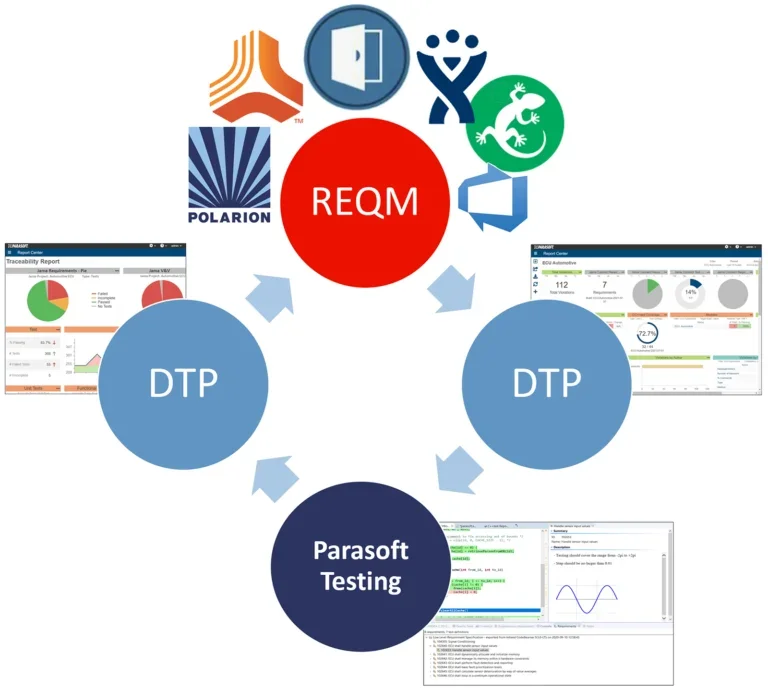
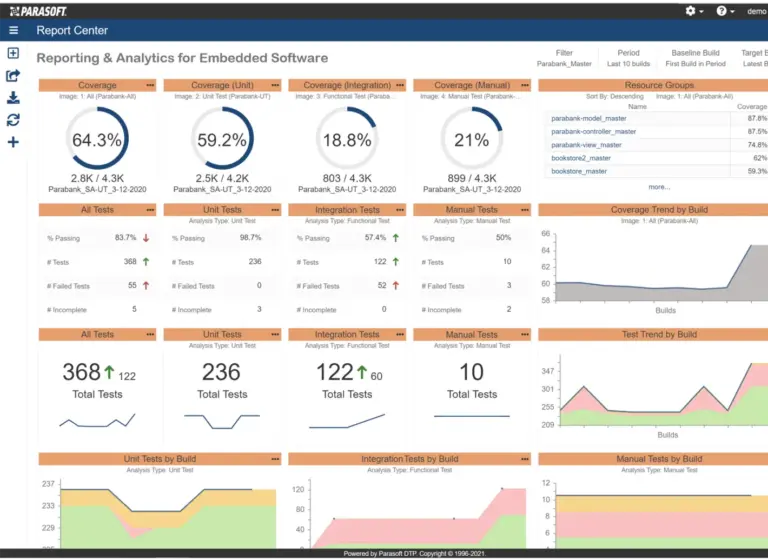
Reporting and analysis provide insights into the progress, quality, and standards compliance of embedded safety and security-critical applications in C and C++. Parasoft DTP performs analysis and autogenerates comprehensive reports for developers to identify trends, patterns, and areas for improvement to enhance the software reliability and robustness.
Our reporting and analytics solution for embedded software tracks defects, which involves documenting and managing issues identified during development, testing, and deployment. By maintaining a centralized repository of defects and their status, developers can prioritize and address issues in a systematic manner, reducing the risk of critical failures in production.
The combination of our automated testing solutions for C/C++ software development and DTP’s reporting dashboard gives teams a full assessment of compliance with safety standards and regulations. With the generated compliance reports and metrics, developers can demonstrate that software meets the required criteria and has undergone thorough validation and verification processes. This is particularly important in safety-critical industries where adherence to standards such as ISO 26262 and DO-178C is mandatory.
Read Blog: Shift Left Your Safety-Critical Software Testing With Test Automation »

Security-critical testing methods help teams developing enterprise software identify and mitigate vulnerabilities, ensure data integrity, protect against cyber threats, and maintain regulatory compliance. Successful application of these software testing methods helps safeguard the reputation and trustworthiness of organizations.
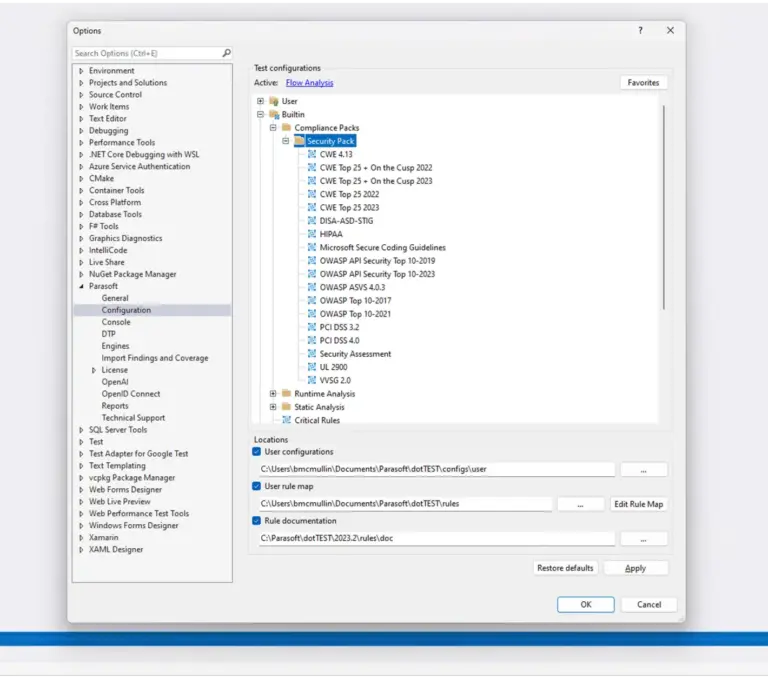
Parasoft static analysis solutions provide robust coverage for secure coding standards such as OWASP, CWE, CERT, PCI DSS, and DISA ASD STIG. Using our solutions, teams can catch vulnerabilities in the earliest stages of development to ensure security.
Jtest and dotTEST offer customizable configurations for teams to tailor analysis based on their security requirements. Generate compliance tracking and documentation for secure coding standards through our reporting and analytics platform, DTP. To streamline vulnerability remediation, Parasoft utilizes AI/ML in static analysis and DTP. This approach enhances the violation workflow in the following ways:
Optionally integrate Parasoft’s static analysis and DTP with OpenAI or Azure OpenAI providers to accelerate the remediation of static analysis findings with AI-generated code fixes. Leverage DTP’s CVE match analysis to get recommendations on which static analysis violations are true security vulnerabilities to prioritize for remediation.
Read Blog: Secure Coding Standards: Enforcing Secure Coding Practices With SAST »
Organizations enforce adherence to specific code coverage requirements to ensure the software they develop is safe, secure, and reliable. Unit testing plays a pivotal role in ensuring compliance for .NET and Java applications by validating the functionality and behavior of individual software units against compliance standards and requirements.
Precision and accuracy are paramount in compliance. Unit testing provides a granular approach to verifying that each component of the application performs as expected and meets compliance criteria.
Our unit testing solutions for .NET and Java applications integrate unit test execution to CI/CD pipelines and gather code coverage analytics. Teams can publish results to DTP to see code coverage analysis over time, identify coverage gaps, and track modified code coverage to ensure all new code meets compliance requirements for code coverage. Leverage Parasoft’s test impact analysis in CI/CD runs to identify and execute the subset of unit tests required to validate code changes and get faster feedback to development.
For Java development teams, Jtest’s AI-enhanced unit test generation rapidly creates unit test suites targeting uncovered lines of code. Teams get actionable recommendations in the IDE to easily extend test cases by adding assertions, parameterization, and mocks or clone test cases to drive higher levels of code coverage.


2x%
Acceleration of unit test generation.
90%
Reduction of test execution time in the CI/CD pipeline.
Shifting left functional security testing for APIs and web UIs is crucial for identifying and mitigating security vulnerabilities early in the software development life cycle. By integrating security testing into the initial stages of development, organizations can proactively detect and address potential security flaws before they escalate into critical issues. Benefits of this approach:
QA teams can codelessly create security test cases for APIs and web UIs with SOAtest by repurposing test cases for functional testing with its out-of-the-box integration with OWASP ZAP or integration with Burp Suite. They can test for security vulnerabilities related to OWASP Top 10, OWASP API Security Top 10, or CWE in concert with their functional testing, avoiding late-stage remediation and rework by finding security vulnerabilities in the earlier stages of the SDLC.
Read Blog: How to Make API Security Testing an Automated Part of the CI Process »


Load and performance testing in software development are essential for security hardening. They ensure that applications meet requirements regarding responsiveness, scalability, and reliability. Compliance requirements often mandate specific performance benchmarks to guarantee that software systems can handle anticipated loads without degradation in functionality or responsiveness.
By conducting performance testing throughout the SDLC, organizations can identify and address performance bottlenecks, latency issues, and resource constraints before deployment. Here’s how Parasoft’s performance testing solutions help.
Read Blog: Optimize Performance Testing With a Shift-Left Approach »
Requirements traceability in software development is indispensable for compliance, ensuring that software applications meet regulatory standards and mandates throughout the SDLC. By establishing a clear link between regulatory requirements, business objectives, and software functionality, requirements traceability enables organizations to demonstrate alignment with regulatory obligations and industry standards.
Integrate Parasoft’s solutions with requirements tracking software like Azure DevOps, Jama, Polarion, or Codebeamer ALM to demonstrate traceability between requirements and the following:
Teams can track alignment with requirements and streamline compliance by generating traceability reports. DTP’s bidirectional integration enables them to maintain a robust traceability matrix, streamline compliance efforts, mitigate risks, and deliver high-quality software applications.
Read Blog: Software Testing Methodologies Guide: A High-Level Overview »

DTP, our reporting and analytics platform, gives organizations the ability to generate comprehensive audit trails and compliance reports, facilitating transparency and accountability. DTP provides analytics for teams to analyze vast amounts of data, identify trends, and detect anomalies that may indicate potential compliance risks or deviations.
Teams can track key performance indicators, assess the effectiveness of compliance initiatives, and make informed decisions to improve regulatory compliance posture continuously. Our reporting and analytics platform also enables teams to do the following:
By integrating reporting and analytics into compliance efforts, organizations enhance regulatory control, mitigate risks, and maintain trust and credibility with regulators, stakeholders, and customers.
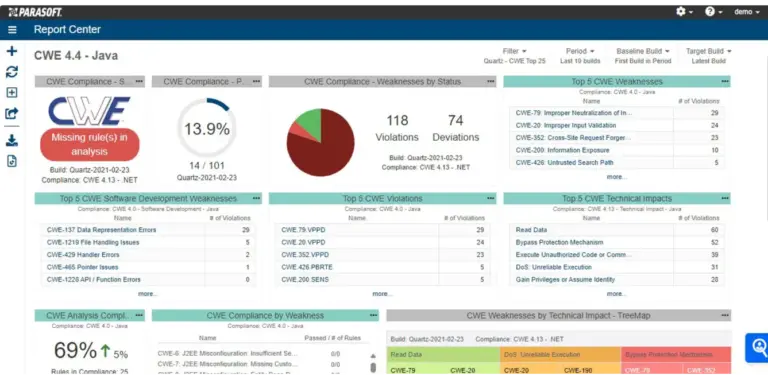

The dashboard and reports in Parasoft DTP helped the software team communicate progress more effectively to management. As these metrics trended in the positive direction, they were able to show the efficiencies and improvements made over time.


Elevate your software testing with Parasoft solutions.